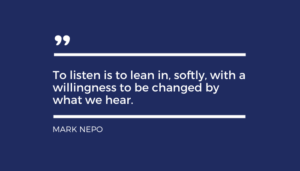Active listening skills aren’t just a nice-to-have. They improve communication, strengthen relationships, boost team performance, spur personal and professional growth, and play a huge role in leadership excellence.
Taken further, active listening is not just functional. It’s effective.
How so? Anyone who has experienced good listening can understand its power. When someone listens to you well, you feel validated, understood, and often more invested in the listener and your shared goals.
Moreover, active listening helps you feel more positive about the interaction itself—even if that interaction makes forays into difficult territory.
Which leads us to our central point:
Active listening is actually the first step toward effective communication—a key component of high-level interchanges that help spur progress and accomplish goals.
Here, we’ll look at 2 key parts of activating your listening skills:
- Part 1: practice active listening techniques
- Part 2: evolve into an engaged, effective listener by employing an easy, 3-step framework
Let’s tune in.
A Closer Look at Active Listening
Active listening hinges on attention and engagement. But before you focus on either, you must choose to approach your improvement with intentionality and determination, because it might be a big change—and challenge!
Begin with these tactics:
Give Full Attention to the Speaker
Attention is key to active listening. Obvious, perhaps. But also far more easily said than done.
How often does your attention wander when you’re listening to someone? And even when you are engaged, something that’s said can easily trigger a memory or opinion in your own brain, at which point your attention moves to your own thinking rather than the words of the speaker.
Awareness is the first step in overcoming this listening trap: accept and be aware that your mind might wander, and when it does, consciously return your attention to the speaker.
By going into the conversation with this awareness, you’re more likely to catch your mistake and fix it.
And go easy on yourself! Everyone’s attention shifts throughout conversations, so don’t get down if progress is slow at first. In fact, you should cheer yourself on for the awareness you’re developing!
The next step is a big help to attention as well.
Convey Interest with Verbal & Non-Verbal Cues
This is a twofer: by making an effort to show that you’re actively listening through your words and gestures, you
- Build the speaker’s awareness that you’re truly engaged
- Help yourself maintain attention on the conversation rather than your own thoughts
 Some examples of verbal and non-verbal active-listening cues include
Some examples of verbal and non-verbal active-listening cues include
- Establishing a physical posture toward the listener
- Responding with understanding word or sounds (e.g., “hmm,” “oh,” “I see”)
- Maintaining eye contact
- Chiming in with questions wherever necessary/appropriate
- Leaning into the conversation
- Reflecting what you hear with facial expressions, such as a smile or a look of surprise
As you practice these active listening techniques, you will not only enhance your overall communication skills but also help others feel comfortable communicating openly and honestly.
From Active to Effective Listening
Effective listening takes all the benefits of active listing and turns up the volume. It helps people and teams build understanding, efficiency, and progress toward goals, such as
- Clarifying a miscommunication
- Sharing an idea
- Working out a disagreement
- Planning a group effort
The key is to communicate understanding and caring through your listening—without saying a word.
We’ve touched on the fact that most effective listening problems are rooted in a focus on self: I’m too wrapped up in thoughts about what I’m going to say next, how I look, whether my breath is okay, and even whether I seem attentive.
The secret to effective listening lies in overcoming this. To do so, we clarify our focus with a simple, other-centered framework:
- Do I hear what s/he’s saying?
- Do I understand what s/he’s saying?
- Do I care about what s/he’s saying?
We’ll call this the HUC framework: Hear, Understand, Care.
Hearing is the first and most basic step: This is where those active listening skills come in. We want to use these tactics to help tune in and really hear the other person, rather than focusing on our own thoughts.
Understanding is the next step: Do the listener’s words make sense to me? If not, am I asking clarifying questions to support my understanding?
Caring is the final and most advanced step: Do I genuinely care about what this person is saying? Am I not just engaged in this conversation, but also invested in it?
Key Point: Effective Listening is NOT Agreement
Notice that none of the HUC questions touch on whether or not I agree.
In fact, the question of agreement distracts me from my ability to listen effectively. It keeps me tuned into myself and what I want to say next.
The HUC questions are specifically designed to help you avoide the distraction of “agree or disagree” and instead practice effective listening.
How to Practice Effective Listening
To start practicing your effective listening skills, begin with this coming week: commit to simply keep the 3 HUC questions in mind during any social or professional conversations.
After this practice period, most people have had some success with HUC—they’ve started exercising their effective listening muscles. But their minds still wander while trying to listen actively. This is normal!
If your thoughts drift while you’re listening, try placing your HUC framework directly into the conversation through questions. This helps you realign your thinking to the effective listening approach. Some examples:
- “So you’re saying that it bothers you when…?” This question, which repeats or rewords a statement from the speaker, reflects your hearing.
- “Let’s see if I understand this right. You feel that this could have been handled without so much conflict by…” This is a great understanding question. You’re taking what you’ve heard and interpreting it to show and confirm your understanding.
- “I can see that you’re upset about the way that was handled.” By identifying the speaker’s emotional response, you are reflecting your care for what they’re discussing.
When you practice these active listening questions, the benefit is twofold:
- It shows the speaker your interest and investment
- It keeps your listening focused: in order to offer a relevant HUC comment or question, you must concentrate on the conversation—which means you’ve practiced active listening!
A Final Note of Encouragement
Active, intentional listening is key to the type of interpersonal communication that ignites solutions and forward progress. But if listening is not your strong suit today, remember this key point:
Good listening is a skill, not an attribute. Here’s a quick rundown on this difference and why it matters:
- A skill can be learned, practiced, and improved. Example: playing the violin.
- An attribute is a natural trait—an inherent strength. While you can optimize attributes, there’s a limit to how much you can do with a true challenge area.
In other words, if you’re no good at listening today, not to worry! You can learn this. And the fact that you know it’s not a skill you’ve mastered is a great first step in becoming an excellent student of it.
Practice, study, and perseverance will reap great rewards. The benefits of your efforts may include
- Increased understanding
- Decreased miscommunication
- Greater trust and loyalty
- Improved relationships
- Better problem solving and collaboration
- Increased success at work
- A larger professional network
- An increased number of social connections
- Higher grades at school
- Growth in self-esteem and confidence
- Better health and well-being
- And on and on…
Happy hearing!




Like the idea of the HUC list. I will be practicing this. Very helpful. Thanks, Bill.
Thank you, Jason. I’m so glad you find that HUC tool helpful. I’ve had feedback that the abbreviation helps keep it front-of-mind, so hope that helps it stick!
Thank you for sharing these important tips on listening Bill.
I work on this daily. Too many people don’t really listen as they’re ready with their own stories before you’ve completed yours. Everyone is in a hurry these days even when listening. Let’s all slow down and hear the whole story.
Have a good day.
Thank you for your comment. Your words”slow down”are perfect…insightful advice!
Thank you for writing about this, I will share with my company’s Leadership Team. Listening is a critical skill, especially for leaders.
It absolutely is! Thank you, Al, for taking the time to comment and encourage. I look forward to learning about the reaction when you share it with your leadership team.